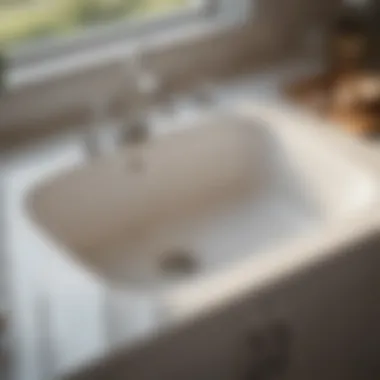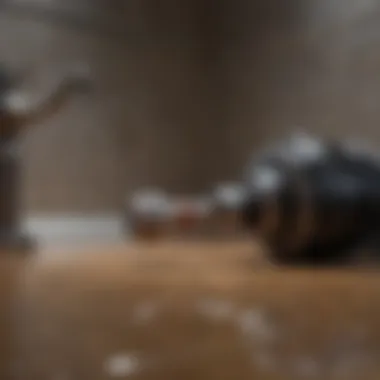Efficient Methods to Unclog Sinks: A Comprehensive Guide


Intro
Clogs can disrupt daily life, especially in kitchens and bathrooms. Understanding effective methods to tackle these issues is crucial for homeowners. This article explores a thorough range of techniques for unclogging sinks. The focus will be on practical solutions, emphasizing how common household items can often resolve these pesky problems.
Being well-prepared and informed is the best defense against sink clogs. A little knowledge about the causes and solutions can go a long way in preventing future incidents. It is essential to explore both traditional methods, such as using a plunger or a drain snake, and newer techniques involving chemical solutions or biologically-based treatments. This guide aims to arm you with the necessary information to ensure your sinks remain functional and efficient.
Understanding Sink Clogs
Common Causes
Sink clogs can result from various factors. Food scraps, hair, soap residue, and grease are frequent contributors. Over time, these materials accumulate and restrict water flow. Understanding these causes can help you take preventive measures to avoid serious blockages.
Preventive Measures
- Regularly clean the sink and its drain.
- Use strainers to catch debris before it goes into the drain.
- Avoid disposing of grease down the sink, as it hardens and causes blockages.
- Occasionally flush drains with hot water or vinegar mixed with baking soda.
By recognizing these common causes and adopting preventive measures, you protect your plumbing system and ensure efficient water drainage.
Traditional Methods to Unclog Sinks
Plunger
A trusted tool in any home, the plunger can often clear minor clogs effectively. Ensure a good seal over the drain and apply steady upward and downward pressure. This can dislodge debris and restore normal flow.
Drain Snake
A more advanced technique involves using a drain snake. This tool consists of a long, flexible coil that can reach deep into the pipes. Insert it into the drain and rotate it while pushing forward to break up the clog.
Innovative Solutions
Chemical Drain Cleaners
Chemical drain cleaners are another option. They dissolve clogs quickly but should be used with caution. Always read and follow the instructions, as some chemicals can damage pipes or be toxic.
Biological Drain Cleaners
Unlike traditional chemicals, biological cleaners use enzymes to break down organic material. These are often less harsh on plumbing and can be an environmentally friendly alternative.
"Choosing the right unclogging method requires understanding both the nature of the clog and your plumbing system."
Advanced Tools
If traditional methods fail, more intricate tools like hydro-jetting might be necessary. This technique involves using high-pressure water jets to clear severe clogs. However, it often requires a professional service.
Maintenance Practices
Routine maintenance can greatly enhance sink performance. Simple habits such as flushing drains with hot water, keeping the sink clean, and using appropriate disposals can prevent significant blockages.
By applying these methods and insights, homeowners can effectively manage and prevent sink clogs. This comprehensive understanding empowers you to ensure your kitchen and bathroom sinks function optimally.
Understanding Sink Clogs
Understanding sink clogs is crucial for maintaining a functional kitchen or bathroom. Clogs can lead to significant disruptions in daily routines. Recognizing what causes these issues can help homeowners take preventive actions. Knowing the signs of clogs can allow for quicker interventions, often saving time and expense.
A clogged sink can stem from various sources. It is vital to investigate underlying reasons thoroughly to apply the correct solutions. Each type of clog presents specific issues and treatments. This understanding lays the groundwork for effectively addressing the problem, ultimately leading to more efficient unclogging methods and promoting better maintenance practices.
Common Causes
Food waste accumulation
Food waste accumulation is a leading cause of sink clogs. Many people dispose of food scraps in sinks instead of designated trash. This practice can form a solid mass that prevents water flow. The consistency of food waste contributes to long-term blockages.
When discussing food waste, it is essential to note that items like oils and fibrous materials tend to clog pipes faster. The unique feature of this cause is its invisibility; many don't realize waste is building up until significant blockage occurs. One advantage of recognizing this issue early is that simple preventive measures, like using a strainer, can be implemented to minimize the problem.
Soap scum buildup


Soap scum buildup in plumbing is another frequent contributor to clogs. When soap mixes with minerals in the water, it creates a sticky residue that clings to pipes. This residue narrows the pipe diameter, reducing drainage efficiency.
The buildup often occurs gradually, so homeowners might not notice until significant clogging happens. This characteristic makes it easy to overlook until the issue becomes severe. Managing soap scum often involves regular cleaning. However, excessive buildup can lead to more severe plumbing issues requiring professional attention.
Hair and debris obstruction
Hair and debris obstruction is particularly common in bathroom sinks. Hair strands often catch on drain components, and when combined with soap, they create a tangled mass that impedes water flow. This type of blockage can happen quickly, making it a frustrating experience for many users.
The unique feature here is that hair can easily accumulate unnoticed, especially in shared spaces. If left untreated, these obstructions can worsen over time. The advantages of addressing this issue early include reduced stress and better hygiene, as standing water can lead to unpleasant odors.
Signs of Clogging
Slow drainage
Slow drainage is a common initial indicator of a clog. When water takes longer than usual to exit the sink, it signifies that something is obstructing flow. This issue can escalate quickly; what begins as a minor inconvenience may develop into a complete blockage.
The primary characteristic of slow drainage is its gradual onset, which many homeowners may dismiss as a temporary problem. Yet, recognizing it early allows for prompt action that can prevent more extensive issues later on. Regular monitoring of drainage speed can provide insights into potential clogs.
Unpleasant odors
Unpleasant odors from a sink are often telltale signs of a clog. This typically occurs when decomposing waste is trapped in the plumbing. A foul smell indicates that the usual water flow is disrupted, leading to stagnation.
One key aspect of unpleasant odors is their ability to alert homeowners to potential problems before they become severe. Addressing odors might involve basic cleaning or deeper inspection of the pipes. If neglected, the situation can worsen, impacting overall home hygiene.
Gurgling noises
Gurgling noises from a sink often indicate an underlying issue. These sounds arise when air is trapped in the pipes due to a blockage. The characteristic of gurgling noises is their distinctiveness; unlike general plumbing sounds, gurgles can be alarming and indicate a need for immediate attention.
These noises can serve as early warnings about an impending clog, which can prompt quick corrective actions before a situation escalates. Responding to these sounds often involves checking the drainage system for potential obstructions.
"An unclogged sink is not just a luxury; it is a necessity to maintain proper hygiene and comfort in the home."
Recognizing sink clogs' causes and symptoms are critical steps. They enable homeowners to take the necessary actions to keep their plumbing systems running smoothly.
Initial Assessment
The initial assessment of a sink clog is crucial in determining the right approach to resolve the issue. Understanding if a sink is partially or fully clogged can save time and effort while increasing the chances of a successful unclogging. It allows homeowners to avoid unnecessary steps that may not effectively deal with the problem, ultimately saving costs. Additionally, a clear understanding of the drainage system is equally important. This knowledge aids in identifying specific challenges linked to the type of sink and its plumbing layout, leading to a more efficient unclogging process.
Is the Sink Fully Clogged?
Determining if a sink is completely clogged is the first step to take when facing drainage issues. Some sinks only experience slow drainage, which can be a sign of early clogging. If the sink retains water and does not drain at all, then it is likely fully clogged. In this case, every attempt to use your sink should be ceased as continued use could worsen the situation.
Assessing the sink's drainage might involve a simple observation of how fast water flows away. If water accumulates quickly or remains stagnant, it indicates that a more nuanced approach to the problem is necessary.
Identifying the Drainage System
Sink Type Considerations
Different sink types play a critical role in how clogs develop and can be resolved. For instance, kitchen sinks often see food particles, grease, and chemical cleaners regularly. This makes them more prone to clogging than bathroom sinks, where hair and soap scum are more common culprits.
Knowing the specific sink type helps in selecting appropriate methods for unclogging. For instance, a double bowl kitchen sink may require specific techniques compared to a standard single basin. Kitchen sinks often feature a trap that needs to be examined for blockages. This understanding is beneficial for effectively addressing the clog, as each sink type has its unique demands and cleaning processes.
Pipe Layout Understanding
Understanding the layout of the plumbing system is vital as it influences clogging. Each pipe layout presents distinct challenges based on its design and material. For example, if the sink is connected to old, corroded pipes or has numerous angles, the likelihood of clogs increases.
Some pipe layouts may also allow easy access for cleaning tools, such as a plumbing snake or chemicals, while others may be harder to navigate. Knowing this can save effort and avoid potential damage to the system. Essentially, familiarizing oneself with the general pipe pathways can help homeowners judge what techniques they can safely apply during their unclogging journey.
Understanding the sink type and the associated pipe layout can effectively guide the unclogging actions you take.
Assessing both the sink’s clogging level and the drainage system offers a foundation for effective unclogging strategies. It equips homeowners with the insights needed to tackle clogs intelligently and prevent future issues.
Basic Unclogging Techniques
Understanding basic unclogging techniques is essential for any homeowner. These methods allow you to address minor clogs without the need for professional help, saving both time and money. Knowing these techniques also builds confidence in handling plumbing issues.


Boiling Water
One of the simplest yet effective methods to tackle sink clogs involves boiled water. This technique works primarily for clogs caused by grease or soap buildup. The heat from the water can dissolve these substances, allowing them to flow down the drain. To implement this method:
- Bring a pot or kettle of water to a boil.
- Carefully pour the boiling water directly down the clogged sink.
- Wait a few minutes and check if the water drains properly.
This method is cost-effective and simple. However, it is essential to ensure that your plumbing materials are compatible with hot water. Some pipes, especially older ones, may not withstand high temperatures.
Baking Soda and Vinegar
Baking soda and vinegar offer a natural solution for unclogging sinks. This combination creates a chemical reaction that can effectively break down debris in the drain. Here is how to use this method:
- Remove any standing water from the sink.
- Pour about half a cup of baking soda down the drain.
- Follow this with half a cup of vinegar.
- Cover the drain and wait for 15-30 minutes.
- Flush the drain with hot water.
This technique can be particularly useful for clogs caused by hair or soap scum. It is safe for most plumbing and is environmentally friendly. However, note that while this method can effectively clear smaller clogs, it may not work for more severe issues.
Plunger Method
The plunger method is a tried-and-true technique for unclogging sinks. It works by creating suction to dislodge the blockage. To use a plunger effectively, follow these steps:
- Fill the sink with a small amount of water, if possible.
- Place the plunger over the drain, ensuring a tight seal.
- Pump the plunger up and down vigorously for a few seconds.
- Remove the plunger and see if the water drains away.
Using a plunger requires some physical effort but can be highly effective for various types of clogs. Ensure the plunger is intended for sink use, as different plungers are designed for toilets. This method is often used as an initial approach before resorting to more advanced techniques.
These basic unclogging techniques are useful for homeowners wanting to maintain their sinks effectively. They help avoid costly plumbing services for minor issues.
Advanced Techniques
In the realm of unclogging sinks, advanced techniques offer solutions that go beyond standard methods. These approaches are essential when dealing with stubborn clogs that basic cleaning methods cannot resolve. By adopting these techniques, homeowners can maintain their plumbing systems more effectively and reduce the likelihood of recurring blockages. Understanding each technique’s purpose and application is crucial for achieving an unclogged sink in a timely manner.
Plumbing Snake Usage
A plumbing snake, or drain auger, is a flexible auger used to dislodge clogs in plumbing. Its design allows it to navigate through curves and bends in pipes. The primary advantage of using a plumbing snake is its capacity to reach deep into the plumbing system, directly addressing clogs that seem unreachable. When using this tool, one must insert it into the drain and rotate it, allowing the auger to latch onto the clog, which can then be pulled out or broken up.
However, it requires some skill. Improper usage can damage the pipes or the snake itself. It can be an effective and economical solution for persistent clogs, especially in kitchen sinks that often contain food debris.
Wet/Dry Vacuum Approach
Another effective method for unclogging a sink is the wet/dry vacuum approach. This tool is capable of both sucking and blowing, making it versatile for different types of clogs. To use a wet/dry vacuum, one can create a tight seal over the drain with the vacuum hose and turn it on to suck out the clog. This can be particularly useful for liquid-based blockages, such as grease or small debris.
One important aspect to note is that vacuums designed for this purpose typically handle water effectively. Using a regular household vacuum could lead to damage and health risk due to water contamination. It is a useful technique for homeowners who have invested in a quality wet/dry vacuum.
Chemical Drain Cleaners
Chemical drain cleaners are another advanced option for unclogging sinks. They consist of powerful substances that dissolve debris, grease, and hair in the pipes. There are various types of chemical cleaners available, each designed for specific types of clogs.
Types of chemical cleaners
Common types include caustic cleaners, oxidizing cleaners, and acidic cleaners.
- Caustic Cleaners: Usually contain sodium hydroxide and generate heat to break down grease. They are highly effective but can be dangerous if mishandled.
- Oxidizing Cleaners: These typically contain bleach or hydrogen peroxide, working by releasing oxygen that effectively dissolves organic matter.
- Acidic Cleaners: Containing sulfuric acid, these are powerful and work quickly, but they require caution due to their corrosive nature.
The main appeal of chemical drain cleaners is their ease of use and effectiveness in removing severe blockages without needing tools. Yet, the risk of pipe damage and the environmental impact should not be ignored.
Safety precautions
Utilizing chemical cleaners necessitates strict adherence to safety precautions. Always read label instructions carefully.
- Protective Gear: Wearing gloves and goggles is vital to prevent skin and eye irritation.
- Ventilation: Ensure ample ventilation when using these products, as fumes can be harmful.
- Avoid Mixing Chemicals: Mixing different cleaners can lead to hazardous reactions.
Recognizing their potential dangers makes safety precautions essential in this article. Chemical cleaners can be a quick solution but require a proactive approach to minimize health and safety risks.
Understanding these advanced techniques equips homeowners to handle sink clogs more efficiently, ensuring functional plumbing systems.
Preventive Measures


Preventive measures are essential strategies to avoid sink clogs before they arise. These actions can save time and money, as dealing with a clogged sink often requires immediate attention, potentially leading to costly repairs or the need for professional plumbing services. By adopting proactive habits, homeowners can maintain a smoother operation of their sinks, helping to ensure longevity and efficiency in the plumbing system.
Regular Maintenance Routines
Monthly inspections
Monthly inspections serve as a foundational aspect of sink maintenance. This proactive approach allows homeowners to identify potential issues before they escalate into significant clogs. Conducting these inspections involves checking the sink's functionality, observing the drain flow, and looking for signs of buildup around the drain. Regular checks can significantly contribute to the overall goal of keeping drains clear.
The key characteristic of monthly inspections is their frequency. It creates a routine that encourages awareness of the plumbing system's condition. This routine is a popular choice for many homeowners, as it requires minimal effort while maximizing benefits.
A unique feature of monthly inspections is the opportunity to catch problems early. This ability to identify early signs can prevent more serious issues, not to mention save on plumbing bills. In this article, emphasizing regular inspections aids in understanding their role in effective sink maintenance.
Proper disposal methods
Proper disposal methods are crucial to maintaining a clog-free sink. Understanding what substances can and cannot be washed down the drain is vital. Foods like grease, fibrous vegetables, and starches can build up and cause blockages over time. Thus, proper disposal directly contributes to the goal of preventing sink clogs.
The notable characteristic of proper disposal methods lies in their straightforwardness. It is a sensible approach that offers an easy way to manage waste, making it a beneficial choice outlined in this article. By advocating proper disposal, readers can appreciate its importance in overall sink hygiene.
A unique aspect of proper disposal methods is the emphasis on educating household members about what should and should not go down the drain. This training can lead to broader awareness and long-term benefits. However, there could be some disadvantages if proper disposal is not followed. It might lead to sluggish drainage and, eventually, more complex plumbing problems that demand immediate action.
Installing Filters
Installing filters can greatly enhance sink efficiency. Filters act as barriers that prevent unwanted materials from entering the drain system, ensuring that only appropriate substances flow through. This measure is especially useful in kitchens, where food debris is common.
Sink strainers
Sink strainers effectively catch larger particles and debris, making them an essential item in every sink. Their primary contribution to the overall objective is reducing the risk of clogs by intercepting potential blockages before they enter the plumbing system. The key characteristic of sink strainers is their simplicity; they are easy to install and maintain, making them a popular choice among homeowners.
A unique feature of sink strainers is their versatility. They can be designed to fit various sink styles and sizes, adding convenience without compromising functionality. Additionally, the advantages of using strainers include easy cleaning processes and affordability. However, some may argue that strainers require regular emptying, which can be seen as a minor inconvenience.
Mesh filters
Mesh filters provide an advanced level of filtration for sink drains, making them also beneficial for upkeep. Similar to strainers, they prevent debris from entering the drain, but their finer mesh catches smaller particles as well. Thus, their role in preventing clogs aligns with the goal of maintaining smooth drainage in sinks.
The key characteristic of mesh filters is their increased efficacy. Their fine structure allows them to capture a wider range of debris. This effectiveness makes them a popular choice in both domestic and commercial settings. A unique aspect of mesh filters is their durability, often designed to withstand frequent exposure to water and waste.
Advantages of using mesh filters include reduced risk of clogs compared to standard strainers. However, their installation can require a bit more effort and may not fit every drain style comfortably.
By adopting these preventive measures, homeowners can not only prolong the life of their sinks but also reduce the chances of encountering frustrating clogs.
Professional Assistance
In certain situations, sink clogs can escalate beyond basic DIY fixes. This is the key point where professional assistance becomes not just relevant, but essential. Understanding when to seek help from a qualified plumber can save homeowners considerable time, effort, and potential damage to plumbing systems.
Calling a plumber carries several benefits. Firstly, professionals are trained to handle diverse plumbing issues. They possess the necessary tools and experience that an average homeowner may lack. This leads to a more effective and efficient resolution. Moreover, attempting to solve a complicated clog without proper knowledge may worsen the problem, incurring additional costs. Professional plumbers have the ability to diagnose underlying problems that contribute to clogs, offering a thorough approach to fix not just symptoms but root issues.
When to Call a Plumber
It’s important to recognize specific circumstances that signal the need for professional assistance. If home remedies such as boiling water or baking soda and vinegar fail to provide relief, it may be time to consult a plumber. Persistent issues may indicate deeper systemic problems, such as tree root intrusion or pipe damage, which require expert intervention.
Some clear signs include:
- Repeated clogs: If your sink clogs happen frequently, it's a sign of a more serious underlying issue.
- Water backup: If water is backing up into multiple drains, it could indicate a blockage further down the drainage system.
- Unusual noises: Strange sounds during drainage may point to air trapped in the plumbing, further highlighting the need for professional help.
Understanding these indicators can help homeowners make timely decisions, potentially avoiding costly repairs down the line.
Cost Considerations
When thinking about professional plumbing help, understanding costs is essential.
Average plumber rates
The average plumber rates vary by location and the complexity of the job. In many regions, the cost per hour can range from 70 to 150 dollars. This rate includes the plumber’s expertise, labor, and travel time. The investment in professional assistance often proves less expensive in the long run when compared to attempts at self-repair that result in further damage.
Another aspect of average plumbing costs involves flat-rate pricing for specific services such as drain unclogging. This is appealing for budgeting, as homeowners can get a clear understanding of what to expect financially.
Evaluating long-term solutions
Evaluating long-term solutions after a clog is crucial for preventing future occurrences. This may include options such as regular inspections and proactive maintenance. Developing a relationship with a trusted plumbing service can offer peace of mind, ensuring quick response times to potential issues.
One unique feature of investing in long-term solutions is the ability to catch minor issues before they escalate into major repair tasks. This approach saves money over time and maintains proper functionality within the plumbing system.
In summary, recognizing the value of professional help in chronic or complicated clogs is imperative. It is not just about fixing the current problem but also about safeguarding your home’s plumbing integrity for the future.















